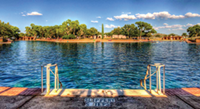Energy issues
As I have recounted several times before, I grew up in West Texas. It’s hot. It’s dry. It’s full of rattlesnakes, scorpions, coyotes and other malicious creatures. And, it looks somewhat like a kitty litter box. But it is also underlain by more oil and gas than almost anywhere else on this planet. And, it is full of really good folks. It’s just getting past that heat, that dryness and those critters.
We West Texans needed respite from the devilish summers, especially in the era before modern air conditioning (we relied on swamp coolers—units that sucked in air across wet straw matting). We needed alternatives to the miles and miles of sand dunes. We needed an oasis—a place with vegetation and cool water to swim in. We needed it badly.
Desert oasis. And we have it in the Balmorhea State Park, Fig. 1. If you were willing to drive 100 mi or so across the stark landscape, and past more wells and tank batteries than you could count, you would come upon trees and vegetation surrounding a natural spring pouring out splendidly cool, beautiful, translucent blue water into one of the world’s largest spring-fed swimming holes. The pool, constructed in the 1930s as part of a federal New Deal program, is fed by San Solomon Springs, an underground spring that puts more than 20 million gal of water per day into the structure. The pool is populated with fish and turtles, and is a destination not only for families but for scuba divers. The view from this freshwater oasis across the Chihuahuan Desert to the Davis Mountains is memorable. It’s like stumbling on paradise in a dry, dusty desert. It was well worth the long drive those many years ago, and still is today.
Alpine High discovery. But, a couple of years ago, its future was considered to be in mortal danger by some, when it was announced that Apache had discovered some 15 Bboe in the adjacent Alpine High, an area that had previously attracted little attention in hydrocarbon-rich West Texas. The backlash began immediately.
Apache spokesperson Castlen Kennedy noted early on that protecting the San Solomon springs and nearby communities was a “top priority” for the company, adding that “we’ve taken a number of important steps to assure both residents and visitors to the area that these unique treasures will be protected. From the outset, we set aside the park, as well as the city limits of Balmorhea … to any oil and gas exploration.” That did not register with opponents and activist groups.
Enviro-groups circle the wagons. Despite Apache’s commitment, environmental groups tried to turn Apache’s plans for the Alpine High into the next big fight in a rolling conflict between the fossil fuel industry and local communities. Several environmental groups, including Defend Big Bend, Big Bend Conservation Alliance, Sierra Club and Earthworks, began to organize, arrange demonstrations, conduct studies that explored the risks to the springs, and educate the region’s residents about the downsides to fracing, noted Naveena Sadasivam in The Texas Observer. “We’re certainly connecting this to the larger issue of protecting water … with the Dakota Access Pipeline, as well as with the Eagle Pass coal mine and the Trans-Pecos and Comanche Trail pipelines in West Texas,” said Tane Ward, an organizing manager with the Sierra Club.
According to Sadasivam, “Ward and other activists also foresee Apache doing damage beyond its well pads. Fracing operations require auxiliary infrastructure, such as pipelines and compressor stations. The more wells that Apache fracs, the more infrastructure it will need. The more infrastructure is built, the more it enables fracing.” Clearly, the area, the city, the spring and the pool were in grave danger from Apache’s unwanted development. Or were they?
Summer fun begins. Fast forward a year and some. The summer (this summer) is beginning, the swimmers will be arriving soon and the pool holding the beautiful, cool waters at Balmorhea are undergoing their annual cleaning. However, during the cleaning process, part of the pool’s structure collapses. It might be a “told you so” moment. But it is not. The Texas Parks and Wildlife Department (TPWD), after thorough investigation, including a rigorous geotechnical examination, concludes that the failure is due to years of undermining erosion behind the pool wall caused by the flow of water from the springs. TWPD estimates repairs will cost $2 million
Apache makes good on promise. And, this is where we tip our hats to Apache. Rather than destroying the area, as some had predicted, Apache has stepped forward with an offer to help fund repairs to the pool in the interest of the community. “Shortly after the pool was closed, we set up a fund for those pool repairs,” said Susan Houston, director of philanthropy at TPWD “And then we received the call from Apache that they wanted to support this extreme need.” Apache will match up to $1 million of the total funds raised, which Houston says the foundation hopes to have done by the end of the year.
In a statement to Marfa Public Radio, Apache’s Castlen Kennedy said the partnership was a “natural choice. The Balmorhea pool is an iconic West Texas destination for Texas families and is critically important to the Balmorhea community.”
And, that’s the other side of the story, a side that happens often but that few want to mention. ![]()




